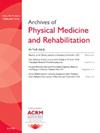盂肱内旋不足与高空运动员上肢受伤的风险:系统回顾。
IF 3.7
2区 医学
Q1 REHABILITATION
Archives of physical medicine and rehabilitation
Pub Date : 2025-01-01
DOI:10.1016/j.apmr.2024.05.027
引用次数: 0
摘要
目的系统回顾高空运动员盂肱内旋不足与上肢损伤风险的文献资料来源:Medline、CINAHL、Cochrane、Embase、Ovid、谷歌学术和 Web Science:在PubMed、Medline、CINAHL、Cochrane、Embase、Ovid、Google Scholar和Web of Science上搜索已发表的相关研究:综述了用英语进行的随机对照试验和准实验,这些试验和实验评估了盂肱内旋缺损(GIRD)的有效性以及进行高举动作的运动员上肢受伤的风险。在 5403 项随机对照试验和两项准实验中,本研究共纳入了 7 项随机对照试验和两项准实验,涉及 360 名参与者:两名审稿人独立筛选文章,对方法学质量进行评分,并提取数据进行分析。综述按照《系统综述首选报告项目》进行和报告。采用物理治疗证据数据库随机对照试验量表对所有研究进行了一式两份的偏倚风险评估:对不同类型技术的疗效进行了评估。关节活动、卧位拉伸、跨体拉伸、肌面松解、腱鞘贴和硬质绑带疗法对疼痛评分和活动范围均有改善。此外,自我面部肌肉松解术往往能改善内旋;卧位拉伸和跨体拉伸往往能改善内旋,使疼痛减轻 40%。急性结果表明,与对照组相比,MET 组治疗后的水平内收 ROM 明显增加(P=0.04)。在水平内收方面,代谢当量组与关节活动度组或关节活动度组与对照组之间不存在差异(P>0.16)。在急性内旋方面,组间差异不明显(p>.28)。在15分钟的事后测试中,水平内收或内旋的组间差异均不明显(P>0.70):总之,该研究评估了各种技术在改善盂兰盆型肱骨内旋功能障碍(GIRD)患者疼痛评分和活动范围方面的疗效。关节活动、卧位拉伸、跨体拉伸、肌筋膜松解、肌筋膜绑带和硬质绑带均能改善疼痛评分和活动范围。然而,在 15 分钟后的测试中,水平内收或内旋的组间差异并不明显。总之,这些研究结果表明,综合运用这些技术可能会有效治疗 GIRD 患者。本文章由计算机程序翻译,如有差异,请以英文原文为准。
Glenohumeral Internal Rotation Deficit and Risk of Upper Extremity Injury in Overhead Athletes: Systematic Review
Objective
To systematically review the literature on the efficacy of addressing glenohumeral internal rotation deficit (GIRD) and risk of upper-extremity injury in overhead athletes.
Data Sources
A search was conducted for relevant studies published in PubMed, Medline, CINAHL, Cochrane, Embase, Ovid, Google Scholar, and Web of Science.
Study Selection
The review focused on randomized controlled trials (RCTSs) and quasi-experiments conducted in English language that assessed the effectiveness of GIRD and the risk of upper-extremity injury in athletes performing overhead movements. The review included 7 RCTs and 2 quasi-experiments out of 5403, which involved a total of 360 participants.
Data Extraction
Two reviewers independently screened the articles, assessed methodological quality, and extracted data for analysis. The review was conducted and reported according to the Preferred Reporting Items for Systematic Reviews. All studies were assessed in duplicate for risk of bias using the Physiotherapy Evidence Database Scale for RCTs.
Data Synthesis
The efficacy of different types of techniques was evaluated, including joint mobilization, sleeper stretch, cross-body stretch, myofascial release, kinesio taping, and rigid taping. These techniques showed improvement in pain score and range of motion. Furthermore, self-myofascial release tends to improve internal rotation; sleeper stretch and cross-body stretch tend to improve internal rotation with 40 percent decline in pain. However, kinesio taping and rigid taping showed positive results for internal rotation. Acute results determined that the metabolic equivalent (MET) group had significantly more horizontal adduction range of motion posttreatment compared with the control group (P=.04). No significant differences existed between MET and joint mobilizations or between joint mobilizations and the control group for horizontal adduction (P>.16). No significant between-group differences existed acutely for internal rotation (P>.28). There were no significant between-group differences for either horizontal adduction or internal rotation at the 15-minute posttests (P>.70).
Conclusions
The study evaluated the efficacy of various techniques in improving pain score and range of motion in individuals with GIRD. Joint mobilization, sleeper stretch, cross-body stretch, myofascial release, kinesio taping, and rigid taping all showed improvements in pain score and range of motion. However, no significant between-group differences were found for horizontal adduction or internal rotation at the 15-minute posttests. These findings suggest that a combination of these techniques may be effective in treating individuals with GIRD.
求助全文
通过发布文献求助,成功后即可免费获取论文全文。
去求助
来源期刊
CiteScore
6.20
自引率
4.70%
发文量
495
审稿时长
38 days
期刊介绍:
The Archives of Physical Medicine and Rehabilitation publishes original, peer-reviewed research and clinical reports on important trends and developments in physical medicine and rehabilitation and related fields. This international journal brings researchers and clinicians authoritative information on the therapeutic utilization of physical, behavioral and pharmaceutical agents in providing comprehensive care for individuals with chronic illness and disabilities.
Archives began publication in 1920, publishes monthly, and is the official journal of the American Congress of Rehabilitation Medicine. Its papers are cited more often than any other rehabilitation journal.

 求助内容:
求助内容: 应助结果提醒方式:
应助结果提醒方式:


